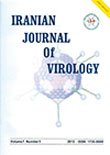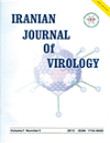فهرست مطالب

Iranian Journal of Virology
Volume:7 Issue: 4, 2013
- تاریخ انتشار: 1392/12/01
- تعداد عناوین: 6
-
-
Pages 1-6Background And AimsHuman parvovirus B19 may transmit to the fetus via the placenta during pregnancy and cause serious complications such as severe fetal anemia, non-immune hydrops fetalis, and even intrauterine fetal death. The aim of this study was to determine the seroprevalence of parvovirus B19 antibodies among young women, Sanandaj, Iran.Materials And MethodsNinety young women (15-40 years old) referring to clinical laboratory, Sanandaj, Iran, from January 2013 until June 2014 participated in this cross sectional study. In a questionnaire demographic data including age, job, education, place of residence, and history of illness, medications, pregnancy, history of abortion, and blood transfusion were collected. Women''s sera were screened for parvovirus B19 IgM and IgG antibodies using ELISA test. The collected data and ELISA results were entered to SPSS statistical software and analyzed using t-test, one-way ANOVA with Tukey post hoc and Chi-squire.ResultsPrevalence of parvovirus B19 IgG and IgM antibodies were 46.7% and 3.3%, respectively in our study population. There were no association between parvovirus antibodies and the demographic variables using t-test, and one-way ANOVA with Tukey post hoc and Chi-squire.ConclusionWe found that more than fifty percent of the subjects were susceptible to parvovirus B19. Also, IgM antibody was positive in 3.3% of women, indicates that there is an active transmission of the virus in our population. Therefore, if this infection occurs during pregnancy may be harmful to the fetus. Paying more attention is needed to determine the B19 immunity, especially in young women ready for marriage and pregnancy.Keywords: Parvovirus B19, Seroprevalence, Antibody, Immunity, Women
-
Pages 7-13Background And AimsDuring the last years a new Foreskin cell line strain (RFSC) has been isolated, characterized and stored in a representative cell bank stock in liquid nitrogen as a part of HCB (Human Cell Bank) development program in Razi institute.Materials And MethodsThe cell population was serially passaged for mass production purpose based on WHO schedule. The controls on pool samples were carried out upon our sampling method and international recommendations.ResultsThe data concerning parameters as well as the result of compulsory controls on Kario logy oncogenicity, cross contaminations, species specificity, no oncogenicity, and mycoplasma free of a human cell line that contained heteroploid chromosomal characterizations are performed.ConclusionKariological examination found an obvious discrepancy in the frequency of aberrations due to high passage level that produced a heteroploid continuous cell line. Virus susceptibility shows RFSC-1 more sensitive to RS#12 Mumps virus strain. This cell line is completely sterile and has no any cross contamination to other pathogen and can be used for production and control of Mumps vaccine.Keywords: Primary culture, Cell Characterization, Human Cell Bank, RFSC, 1
-
Pages 14-20Background And AimsFresh Frozen Plasma (FFP) is one of blood components. The risk of transmission of viruses from blood components regardless selection of blood donors and screening donated blood still remains. There are several methods for viral inactivation. In this study methylene blue (MB) photo inactivation process was used for inactivating viruses.Materials And MethodsIn this study Methylene Blue(MB) was used in final concentration of 1µM. Infected Fresh Frozen Plasma (FFP) illuminated by 143Pieces (PCs) of 1 w red Light Emitting Diodes (LEDs) from two side for 10,15 and 30 minutes and shacked 30 cycle in minutes. The central wavelength of these LED is 627 nm with 20 nm Full Width at Half Maximum (FWHM).Herpes simplex virus-1(HSV-1) and vesicular stomatitis virus (VSV) were used as model viruses to evaluated illumination effects on viral inactivation. Level of fresh frozen plasma (FFP) coagulation factors such as fibrinogen, FV, FVIII, protein C, antitrombin measured pre and post illumination.ResultsInitial HSV-1 and VSV titer were calculated to be 107 and 106.5 TCID50/ml, respectively. The level of viral inactivation was expressed as log-reduction. Titer reduction of HSV for 10, 15 and 30 minutes irradiation with shaking was>6, ≥7 and ≥ 7 logs, respectively. The ratio of coagulation factors activity remaining unchanged after pathogen inactivation with MB calculated. Illumination had major effects on the mean levels of fibrinogen and FVIII. Significant differences between level of factors before and after illumination were evaluated with a t test for paired samples. No significant differences were seen in the FFP coagulation factors before and after illumination (P˃0.05).ConclusionAs results show the optimum time for viral inactivation were adjusted to be 15 minutes. Due to the reduction of virus titer at various times, agitation with illumination is effective.Keywords: methylene–blue, light, virus inactivation, shacking
-
Pages 21-28Background And AimsThe contribution genetic and antigenic diversity of H9N2 influenza viruses in evading from immune responses, cytotoxic T lymphocytes (CTL) epitopes in hemagglutinin (HA) protein restricted by HLA binding peptides was identified.Materials And MethodsPhylogenetic analyses were carried out for all of full length HA and deduced amino acid sequences of H9N2 viruses available in GenBank from their emergence to now. The impact of amino acid substitutions on emergence of antigenic variants was evaluated by using in silico prediction of the HLA-A*0201 binding peptides within HA protein. Potentially changes in structure and antigenic function of HA protein were quantified.ResultsThe viruses phylogenetically clustered in Middle East and China. HA protein of the Middle East viruses represented a single sublineage, G1-like, while China isolates grouped to various sublineages and genotypes. Despite Middle Eastern viruses, more variations found in CTL epitopes of China isolates correlated to phylogenic analysis. Quantify and scoring of HA epitopes revealed that structure and antigenic function of the protein was not changed within H9N2 viruses during the previous decades indicating viral recognition by host-specific CTL response was not affected.ConclusionUsing an evolutionary and immunological approach, we showed that substantial levels of immunogenic peptide conservation for H9N2 HA protein was presented by HLA-A*0201. The potentially pre-existing immunity to H9N2 viruses in human is important for determining the outcome of influenza infection and developing vaccine with a T cell–based component against the public health threat.Keywords: H9N2 influenza virus, CTL epitope, HLA, A*0201 binding peptide, immunity
-
Pages 29-36Background And AimsInfectious bursal disease (IBD) is an acute contagious viral disease of birds worldwide. The causative virus induces a persistent immune suppression following destroy B lymphocytes precursors in bursal lymphoid follicles. Vaccination is the main strategy for prevention of the disease in commercial poultry industry.Materials And MethodsTo produce a live vaccine against the disease, an new virus strain was isolated from the affected bursa of Fabricius. Diagnostic serological tests, histopathology and molecular examinations were done for pathotyping the isolate.ResultsThe results indicated that the virus is a new strain and named IBD07IR. In case of developing live IBD vaccine, the bacteriology, purity, titration, reversion to virulence, bursa-body index, immunosupression and efficacy tests were performed on the candidate vaccine virus seed. The live vaccine was produced following propagation of the IBDV seed in SPF embryonated eggs. The proper dose of the vaccine was found by administration of SPF chicken groups. Afterward, the laboratory trial was scaled and the clinical trials were done three times with different administration routs.ConclusionAccording to serological assays and challenge, the developed live IBD vaccine induces an adequate immunity in both SPF and commercial chickens and had no adverse effects.Keywords: Infectious Bursal Disease, Intermediate, Poultry, Vaccine, Production
-
Pages 37-41Background And AimsHepatitis C virus is one of the viral infections which is mainly transmitted by blood transfusion. Patients with thalassaemia frequently need blood transfusion and are in danger of HCV infection. In most cases of infection (85%) the virus evades the immune system and establishes a chronic infection that may lead to cirrhosis and liver carcinoma. Liver is the main site of HCV replication; HCV RNA has been detected in circulating extra hepatic sites, such as in peripheral blood mononuclear cells (PBMC). It has been proposed that PBMC could be the source of recurrent HCV infection. The aim of this study was to investigate the presence of HCV RNA in PBMCs of thalassaemia patients with hepatitis C after antiviral treatment.Materials And MethodsAbout 261 (179 with and 82 without thalassaemia) patients with HCV infection after treatment, 20 patients with HCV infection without treatment and 20 healthy samples as control groups were analyzed in this study. Blood samples were collected in a sterile tube containing EDTA. PBMC was separated from blood of HCV infected patients and control groups by density gradient centrifugation. Viral RNA was extracted from plasma and PBMCs by the guanidium isothiocyonate method. The extracted RNA was amplified by RT-PCR method. Anti-HCV ELISA was performed on all samples.ResultsAbout 92.7% of HCV infected patients were undetectable for HCV RNA in plasma and PBMCs samples after treatment. But HCV RNA was detected in plasma and PBMCs samples 6 of 82 (7.3%) patients with chronic HCV after treatment. After antiviral treatment, 146 of 197 (74.2%) patients with thalassaemia were undetectable for HCV RNA and 25.8% (51 of 197) of them had HCV RNA in plasma or PBMCs samples which in two cases, HCV RNA was detected only in PBMC.ConclusionMore than 90 percent of patients had clearance of HCV RNA in both serum and PBMCs after 5 years of response to antiviral treatment while 74.2% of Patients with thalassaemia is achieved to SVR after antiviral therapy. Therefore, the presence of the persistent virus in mononuclear cells of patients may cause hepatitis C virus recurrences at the end of treatment.Keywords: HCV, sustained virologic response (SVR), RT, PCR, antiviral Treatment


